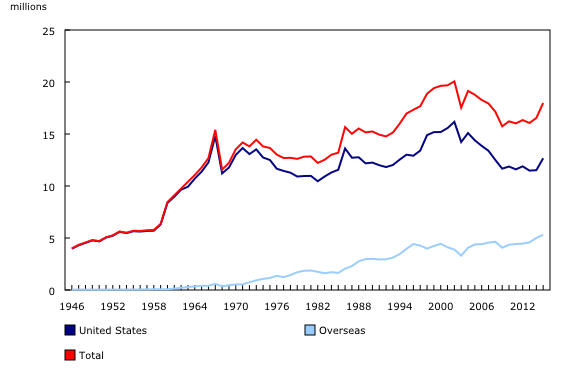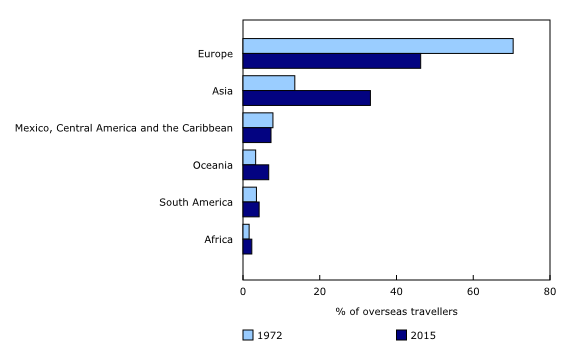Canadian Megatrends: The evolution of Canadian tourism, 1946 to 2015
Archived Content
Information identified as archived is provided for reference, research or recordkeeping purposes. It is not subject to the Government of Canada Web Standards and has not been altered or updated since it was archived. Please "contact us" to request a format other than those available.
Released: 2017-01-16
As Canada invites the world to its 150th birthday party, we remember the country's last big birthday bash—its centennial back in 1967, when Montréal hosted the International and Universal Exposition, a milestone for Canadian tourism. This month's edition of Canadian Megatrends, "The evolution of Canadian tourism, 1946 to 2015," offers a look at travellers to and from Canada from 1946 to 2015.
In 1946, roughly 4 million international tourists came to Canada; by 1967, the figure had risen to more than 15 million. Since then, major events such as recessions and the SARS (severe acute respiratory syndrome) outbreak, and movements in the Canadian dollar, have had major impacts, positive and negative, on the number of tourists visiting Canada. In 2015, Canada welcomed nearly 18 million tourists.
There was a time, too, before the advent of widespread commercial air service, when almost all international tourists to Canada came from over the Canada–United States border. While most tourists still come from the United States, an increasing number are coming from overseas.
For instance, from 1946 to 2015, the number of overseas tourists to Canada rose from 27,000 to over 5 million. In 2015, nearly 30% of all tourists to Canada came from countries other than the United States.
Over the years, the countries of origin for these overseas visitors also changed. Historically, most overseas travellers came from Europe, with Europeans accounting for 70.4% of all overseas travellers to Canada in 1972. However, their share fell substantially over the years and, by 2015, Europeans represented 46.3% of all overseas travellers to Canada.
Conversely, Canada received increasingly more visitors from Asia, particularly China, over this period. In 2015, Asian travellers accounted for 33.2% of overseas travellers to Canada, up from 13.5% in 1972.
Note to readers
International travellers are people arriving in Canada who are cleared through Canada Border Services Agency points of entry, divided into three mutually exclusive groups: non-resident traveller (traveller residing in a country other than Canada arriving in Canada), resident traveller (traveller residing in Canada returning from outside of Canada) and other traveller (e.g. crews and immigrants). Figures for other travellers are excluded for the purposes of this paper. The duration of the travel must be for a period of less than one year.
An international tourist is an international traveller taking at least an overnight trip.
An overseas traveller is a traveller to Canada from a country other than the United States.
Canadian trips abroad correspond to the number of Canadian tourists returning from travel to other countries.
Products
The article "The evolution of Canadian tourism, 1946 to 2015," part of Canadian Megatrends (11-630-X), is now available.
Contact information
For more information, contact us (toll-free 1-800-263-1136; 514-283-8300; STATCAN.infostats-infostats.STATCAN@canada.ca).
To enquire about the concepts, methods or data quality of this release, contact Sean Clarke (613-796-9238; sean.clarke@canada.ca), Analytical Studies Branch.
- Date modified:



